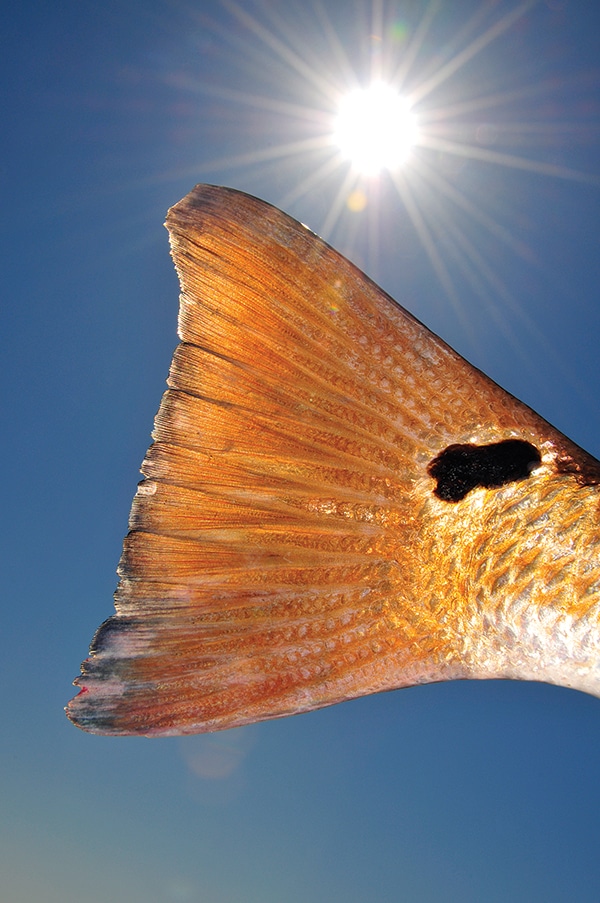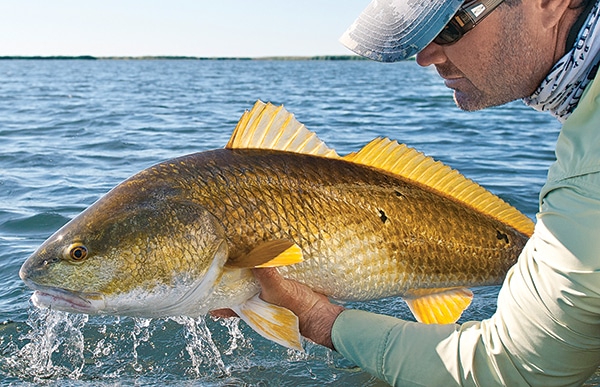Over the years, I have repeatedly been asked “Why are redfish such a great fish to pursue on fly tackle?” I have typically responded with a short answer, but recently I’ve given the question a little more thought.
As as redfish guide, I’ve always found it interesting that anglers around the country can pursue the same species but use such varying techniques to catch them. You can catch them so many ways on fly gear. You can stalk them on foot by wading, sneak up on them in a kayak or a canoe, pole for them in a flats skiff, approach them with a trolling motor on a bay boat — you can even target them in deep water from an offshore boat. Sight-fishing for them in shallow water gets most of the press, but the opportunity to “dredge” or throw heavy sinking lines in deeper water is there. Actually, some of the largest redfish are targeted this way off the coast and in the inlets of the mid-Atlantic and Northeast.
Though they can be finicky at times, redfish have quite a diversified palate and will eat pretty much anything, including shrimp, crabs and baitfish.
Due to the anatomy of their mouths, redfish primarily feed off the bottom. In my humble opinion, seeing a redfish tail in shallow water is one of the coolest visuals in fly-fishing. No matter how many times you see it, it never gets old. I don’t know exactly how long redfish have existed, but what I do know is that they have adapted well in the art of eating. While they are anatomically designed to feed on the bottom, they do not discriminate against forage swimming in the middle or even the top of the water column. That being said, they will eat nonweighted baitfish and streamer-style flies in addition to crab and shrimp patterns. In some cases, topwater flies will draw favorable reactions. Some of the more comical redfish experiences I’ve witnessed have been watching redfish try to eat flies on the surface. Their broad head and shoulders push a big and unmistakable wake, which pushes topwater flies away. No matter how much they track and try to eat them, they just keep pushing them away from their mouths. It’s almost like dangling carrots in front of mules — they keep trying for them but they just can’t get them. The other topwater error that redfish often make is undershooting and biting a foot in front of the fly — that one cracks me up every time. When it comes to tying redfish flies, don’t limit your imagination.
Nobody can argue how exciting it is to see a group of redfish pushing down a shoreline with their backs so far exposed that you can practically see their eyes. Or a single fish tailing hard in water so calm that it looks like a mirror. Or a school of 100-plus, or even 1,000, redfish floating. The scenarios are endless, and that is one of many reasons why they are such great fish. On any given day, you never know what to expect when targeting reds.
Also, because of their hardy nature, they can handle cold water as well as warm water, which means you can catch them year-round. In some regions, redfish can be very forgiving, which is great for beginners, but in others, they can be as difficult to catch as a skinny-water permit. They eat aggressively and pull hard. Ultimately, it’s no surprise that redfish have become such a popular game fish.
The species has been through a lot. Overnetting, loss of habitat and water quality issues have affected redfish populations greatly. Thankfully, they are resilient. While rule makers have acknowledged their value and have protected them, they still need to recognize and act on the loss and/or depletion of their habitat. Whether it’s the disappearing Louisiana marsh or water quality issues in Florida, we need to continue to move forward and
protect the environments that this outstanding game fish calls home.












